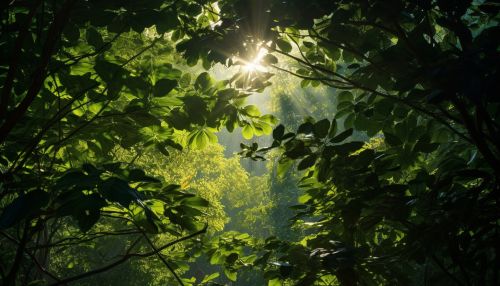The Ecology of Forest Canopy and Its Role in Biodiversity
Introduction
The ecology of forest canopy, often referred to as the "last biotic frontier," is a critical yet underexplored aspect of forest ecosystems. The forest canopy, the uppermost layer of vegetation in a forest, is a unique and complex environment that plays a significant role in biodiversity, climate regulation, and carbon sequestration. This article delves into the intricate ecology of the forest canopy and its vital role in supporting biodiversity.


Forest Canopy: An Overview
The forest canopy, often referred to as the "roof of the forest," is the uppermost layer of a forest, composed of the crowns of the tallest trees. This layer is a dynamic and complex environment, characterized by a high degree of spatial and temporal variability. The forest canopy is home to a rich array of organisms, from epiphytes and lianas to a multitude of invertebrates and birds, many of which are uniquely adapted to life in the treetops.
Ecology of the Forest Canopy
The ecology of the forest canopy is shaped by a multitude of factors, including light availability, moisture, temperature, and the physical structure of the canopy itself. These factors influence the distribution and diversity of species within the canopy, as well as the interactions between these species and their environment.
Light Availability
Light is a critical resource in the forest canopy, influencing both the distribution of organisms and the processes they carry out. The forest canopy intercepts the majority of sunlight, creating a gradient of light availability from the top of the canopy to the forest floor. This light gradient influences the distribution of photosynthetic organisms, such as trees and epiphytes, as well as the behavior of many animal species.
Moisture and Temperature
The forest canopy also plays a crucial role in regulating moisture and temperature within the forest. The canopy intercepts rainfall, reducing the amount of water that reaches the forest floor and creating a humid microclimate within the canopy. This moisture gradient, along with the temperature gradient created by the canopy's insulation properties, influences the distribution and behavior of organisms within the forest.
Physical Structure
The physical structure of the forest canopy, including the arrangement and density of tree crowns, branches, and leaves, shapes the habitat available to organisms. This structure creates a complex three-dimensional environment, with a high degree of spatial heterogeneity. This heterogeneity contributes to the high biodiversity found within the forest canopy, as different species are adapted to different microhabitats within the canopy.
Biodiversity in the Forest Canopy
The forest canopy is a hotspot of biodiversity, home to a large proportion of the world's species. This biodiversity is driven by the complex and dynamic nature of the canopy environment, as well as the multitude of niches available within the canopy.
Flora
The forest canopy is home to a diverse array of plant species, including trees, epiphytes, and lianas. These plants are uniquely adapted to life in the canopy, with adaptations such as specialized root systems for epiphytes and climbing mechanisms for lianas. The diversity of plant species in the canopy contributes to the overall biodiversity of the forest ecosystem.
Fauna
The forest canopy also supports a rich diversity of animal life. Many species of birds, mammals, reptiles, and invertebrates are adapted to life in the canopy, utilizing the resources and habitats available in this unique environment. The canopy provides food, shelter, and breeding sites for these species, contributing to the high biodiversity of the forest ecosystem.
Role of the Forest Canopy in Biodiversity
The forest canopy plays a crucial role in supporting and maintaining biodiversity. Through its influence on microclimate, habitat availability, and resource distribution, the canopy creates a multitude of niches that support a diverse array of species.
Habitat Provision
The forest canopy provides a variety of habitats for different species. The physical structure of the canopy, with its complex arrangement of branches, leaves, and epiphytes, creates a multitude of microhabitats. These microhabitats support a diverse array of species, each adapted to a specific set of conditions within the canopy.
Resource Distribution
The forest canopy also influences the distribution of resources within the forest, contributing to biodiversity. By intercepting sunlight and rainfall, the canopy creates gradients of light and moisture that influence the distribution of species within the forest. Additionally, the canopy provides a variety of food resources, from leaves and fruits to invertebrates and other animals.
Microclimate Regulation
The forest canopy plays a crucial role in regulating the microclimate within the forest, influencing biodiversity. By intercepting sunlight and rainfall, the canopy moderates temperature and humidity within the forest. These microclimatic conditions influence the distribution and behavior of species within the forest, contributing to the high biodiversity found in forest ecosystems.
Conclusion
The ecology of the forest canopy is a complex and dynamic field, with the canopy playing a crucial role in supporting and maintaining biodiversity. Through its influence on microclimate, habitat provision, and resource distribution, the forest canopy creates a multitude of niches that support a diverse array of species. Understanding the ecology of the forest canopy and its role in biodiversity is crucial for conservation efforts, as the loss of this unique environment could have profound impacts on global biodiversity.
